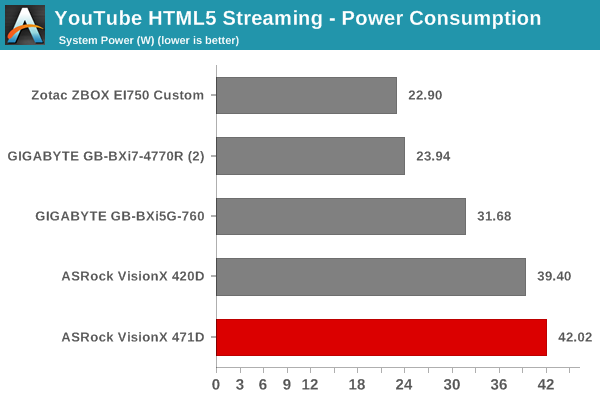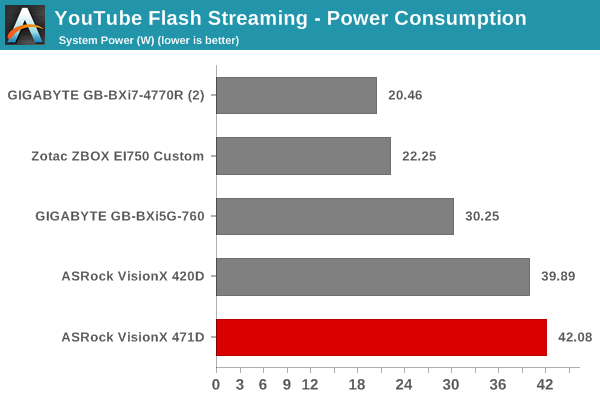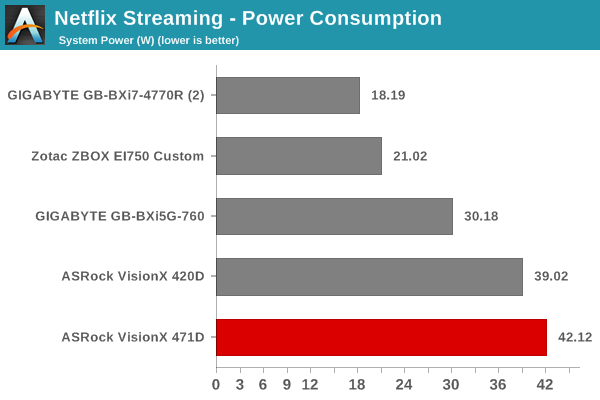ASRock VisionX 471D Review - Evolutionary Upgrades for a Powerful mini-PC
by Ganesh T S on January 26, 2015 6:00 AM ESTHTPC Credentials
The VisionX 471D has a much better acoustic profile compared to the BRIX Pro and even the ZBOX EI750 (thanks to the larger chassis, which, in turn, allows for a better thermal solution). Subjectively speaking, I found it to be ideal for a gaming HTPC, but it is definitely no substitute for an actively cooled NUC or passive HTPC. On the performance side, the AMD R9 270MX should be capable enough for madVR, but we will try to identify the limits in this section. Prior to tackling that, we have two HTPC aspects to explore.
Refresh Rate Accurancy
AMD and NVIDIA have historically been able to provide fine-grained control over display refresh rates. The default rates are also quite accurate. Intel used to have an issue with 23 Hz (23.976 Hz, to be more accurate) support, but that was resolved with the introduction of Haswell. As expected, the ASRock VisionX 471D has no trouble with refreshing the display appropriately in the 23 Hz setting. The accuracy is not as much as what we could get with Haswell and Bay Trail-based systems.
The gallery below presents some of the other refresh rates that we tested out. The first statistic in madVR's OSD indicates the display refresh rate.
Network Streaming Efficiency
Evaluation of OTT playback efficiency was done by playing back our standard YouTube test stream and five minutes from our standard Netflix test title. Using HTML5, the YouTube stream plays back a 720p encoding, while Adobe Flash delivers a 1080p stream. Note that only NVIDIA exposes GPU and VPU loads separately. Both Intel and AMD bundle the decoder load along with the GPU load. The following two graphs show the power consumption at the wall for playback of the HTML5 stream and the Adobe Flash stream in Mozilla Firefox (v 35.0). The Flash plugin version used for benchmarking was 16.0.0.257. GPU load was around 7.06% for the HTML5 stream and 4.5% for the Flash stream.


Netflix streaming evaluation was done using the Windows 8.1 Netflix app. Manual stream selection is available (Ctrl-Alt-Shift-S) and debug information / statistics can also be viewed (Ctrl-Alt-Shift-D). Statistics collected for the YouTube streaming experiment were also collected here. GPU load in the steady state for the Netflix streaming case was 1.85%.

Decoding and Rendering Benchmarks
One of the major 'HTPC' drawbacks we had reported in our VisionX 420D review was the absence of hardware decode acceleration for 4K H.264 clips. Recently, ASRock released a new BIOS version (v 2.0), which added a new option to enable multiple monitors with the Intel iGPU. Intel's Quick Sync decoder is one of the best in the business, and, with Haswell iGPUs, it can decode 4K videos without any problems. We enabled this BIOS option, configured a new monitor (with an extended desktop) using the Intel HD Graphics GPU to drive it even in the absence of a physical display. This allows for Intel Quick Sync to be used with LAV Video Decoder in MPC-HC.
In order to evaluate local file playback, we concentrate on EVR-CP and madVR. We already know that EVR works quite well even with the Intel IGP for our test streams. Under madVR, we used the default settings initially. We also put together a 'madVR stress configuration' with the upscaling algorithms set to Jinc 3-tap with anti-ringing activated and the downscaling algorithm set to Lanczos 3-tap, again with anti-ringing activated. The decoder used was LAV Filters bundled with MPC-HC v1.7.7
| ASRock VisionX 471D - Decoding & Rendering Performance | ||||||
| Stream | EVR-CP | madVR - Default | madVR - Stress | |||
| GPU Load (%) | Power (W) | GPU Load (%) | Power (W) | GPU Load (%) | Power (W) | |
| 480i60 MPEG2 | 34.5 | 36.63 | 27.53 | 44.92 | 52.48 | 59.49 |
| 576i50 H264 | 30.06 | 36.72 | 35.15 | 46.45 | 53.25 | 61.64 |
| 720p60 H264 | 33.17 | 39.04 | 29.47 | 48.55 | 74.24 | 67.46 |
| 1080i60 MPEG2 | 29.48 | 44.14 | 40.59 | 51.19 | 53.71 | 60.33 |
| 1080i60 H264 | 31.21 | 44.73 | 38.80 | 51.65 | 54.78 | 61.02 |
| 1080i60 VC1 | 28.97 | 44.61 | 34.10 | 50.53 | 52.71 | 60.37 |
| 1080p60 H264 | 45.21 | 41.09 | 42.02 | 49.04 | 53.66 | 62.90 |
| 1080p24 H264 | 30.38 | 38.39 | 26.03 | 38.26 | 36.32 | 48.39 |
| 4Kp30 H264 | 23.33 | 40.51 | 33.26 | 55.50 | 91.02 | 75.87 |
The results present no marked departure from what we observed in the VisionX 420D review, despite decoding duties being take up by the Intel Quick Sync engine. 4Kp30 with stressful madVR processing for display on to a 1080p screen was not a pleasant exercise (too many dropped frames). One other aspect that helped in smooth playback of other streams was the setting of different internal queue sizes to the maximum possible values in the madVR settings.
















30 Comments
View All Comments
Zizy - Monday, January 26, 2015 - link
I don't see the point of this. Not good enough for fhd gaming, too expensive and power hungry for a HTPC.As for HTPC duties, what about testing 4K@60 and FHD@60 (both with H.265)? Not really needed now, but I would rather get something future proof, especially for this kind of money.
Daniel Egger - Monday, January 26, 2015 - link
I totally agree. My (Desktop-grade) Haswell Core i5 with 750 Ti OC uses less in Idle and only slightly more under FurMark load yet is a completely different beast allowing for Full HD gaming despite running very quietly and staying cool.heffeque - Monday, January 26, 2015 - link
If you want hardware h.265 4K60p, you'll have to wait until Carrizo comes around.MLSCrow - Monday, January 26, 2015 - link
I honestly believe that Carrizo, is going to be the greatest HTPC/MiniGamingPC APU when it comes out and probably the first AMD processor that is worth purchasing since the Phenom II. Granted, they aren't going to release a Desktop version strait away if ever, and instead are releasing a Kaveri update, which is, meh, imo, but whatever...I'm just waiting for Zen to shock the world with it's Intel dominating performance, until Intel copies it, puts more money into it, and produces a better performing product, as they always have.baii9 - Monday, January 26, 2015 - link
I believe Intel had the lead on hardware 4k decode for a while, so stick with igpu? :)kmmatney - Monday, January 26, 2015 - link
yes - this is pretty neat, but you can get a laptop with better specs at this price, and inlcudes a screen and it portable. This system doesn't really need such a high end processor.britjh22 - Tuesday, January 27, 2015 - link
I'm guessing this would actually be decent at FHD gaming, just not at the presets/detail settings that are used for AT's testing. I would really like to see a second detail setting for FHD be tested, as just because it fails at ultra settings doesn't mean it would at high/medium.boe - Tuesday, February 3, 2015 - link
I definitely want lot's of 4K goodness! I don't care if it makes it bigger use heat radiators and lose the fan. Offer a black model to match my other HT equipment as well. Offer a model without a disc player as I'm only using this to stream from a server.Rafterman - Saturday, February 21, 2015 - link
H.265 not really needed now, I would dissagree. AFAICS H.265(HEVC) is fast replacing AVC.ToTTenTranz - Monday, January 26, 2015 - link
The GPU's PCB seems to be risen above the motherboard's level.Is the M270X a MXM module? Can it be changed?